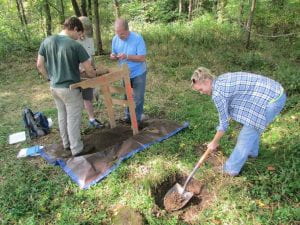By Samantha Taylor (M’ 18) and Angela Jaillet-Wentling (M’ 11)
Nestled along a rural road in Mercer County exists a partially wooded property intersected by a small creek known as the Indian Run. If you drove past this property, it would likely not catch your eye. The site’s location blends in with the larger agricultural landscape of Mercer County. It and its story might be easy to miss save for a blue historical marker that has adorned the edge of Route 19, one of the more-frequented roads in the region since November 2019. The pristine marker reads:
“PANDENARIUM. Arriving in November 1854, 63 African Americans Settled an agricultural community north of Indian Run. Freed through manumission by Va. Plantation owner Dr. Charles Everett, many of these formerly enslaved men and women worked to purchase the freedom of others. Abolitionist-built houses on land provided by Everrett awaited them. Archaeological investigations have uncovered their stories of hard-fought freedom, collaboration, and perseverance.”
Though historical markers play a significant role in validating and commemorating historical spaces, in the case of Pandenarium, it serves as a brief introduction to a complex cultural and social landscape that still resonates with descendants and the broader African American community in northwestern Pennsylvania.
Since 2011, archaeology has been a driving force in the interpretation and dissemination of the story of Pandenarium. Early work at the site was focused on exploring the settlement’s location and layout, in many ways disproving local narratives steeped in racial bias. Such narratives suggested that the people of Pandenarium were unable to contend with seasonal flooding and harsh Pennsylvania winters and that the settlement was a short-lived failure.
In 2011, Angela Jaillet-Wentling (M’11) published her thesis detailing the results of extensive background research, landscape analysis of the site involving Ground Penetrating Radar, Light Detection and Ranging (LiDAR), and excavation. Her analysis determined that the settlement persisted into the first couple decades of the twentieth century. During their time along the Indian Run, the settlers began to expand outward from the homes built by local abolitionists in the center of the property. Succeeding generations built their homes along the Indian Run and nearer to the main road, giving them access to the broader community while altering the landscape to suit their needs.
In 2017, Pandenarium was revisited as the subject of a comparative ceramic analysis conducted by Samantha Taylor (M’18). This analysis sought to compare Pandenarium to similar African Diaspora sites, such as Mulberry Row in Virginia and Timbuctoo in New Jersey. The work focused on the residence of John and Rosie Allen, first generation settlers at Pandenarium. The comparative analysis determined that the ceramics recovered from the Allen Residence most resembled those recovered from contemporaneous freedman and fugitive sites, particularly Timbuctoo, suggesting socioeconomic similarity amongst freedman and fugitives from enslavement.
While both theses were completed nearly seven years apart, we have since partnered to pursue opportunities to spread the story and its implications on how we understand the legacies of slavery and freedom for African Americans in the antebellum North. In addition to presentations at local, regional, and national conferences and workshops, we worked with the local historical society to nominate the site for a Pennsylvania Historical and Museum Commission historical marker. In 2020, the marker was installed at its current location. Last year, we published an article entitled, “Finding Freedom: Exploratory Archaeological Investigations at the Free African American Site of Pandenarium (36ME253), 1854–1930s” in Historical Archaeology.
Most importantly, the public outreach and publications helped spread the story to others who spread the word to descendants of the community. In 2019, Bill Davison and his daughter, Amanda, reached out in regard to their ancestors, Lucy Myers and William Reeves, two of Pandenarium’s original inhabitants. Bill’s genealogical research piqued the interest of another researcher who then put him in contact with Angie. In 2021, local history buff and bike enthusiast, Frank Bell, identified and coordinated a meeting with descendants of John and Rosie Allen to include Rev. Dr. Bryan CrawlCharlene, Jeffrey, and Sarita Rankin, as well as, Darrell and Jodie Warden. Identifying the descendant population has been a boon and it is our hope that we can continue to support the research and ever-expanding narratives coming out of the site of Indian Run/Pandenarium as new voices join our own.

